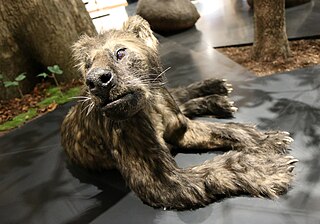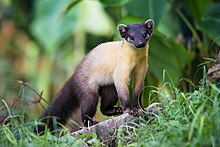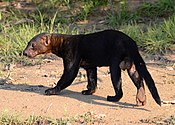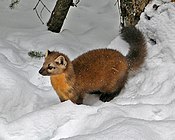
The Mustelidae are a diverse family of carnivorous mammals, including weasels, badgers, otters, martens, and wolverines. Otherwise known as mustelids, they form the largest family in the suborder Caniformia of the order Carnivora with about 66 to 70 species in nine subfamilies.

Gulo is a genus of carnivoran mammals in the family Mustelidae. It contains one extant species, the wolverine, as well as several extinct ones. Fossil evidence suggests that this genus appeared in North America and later spread to Eurasia during the Pliocene. Diagnostic traits include a strongly reduced P2, a robust P4 with three roots, and upper molars smaller than in other gulonines. Overall, the teeth are adapted for hypercarnivory.

The honey badger, also known as the ratel, is a mammal widely distributed in Africa, Southwest Asia, and the Indian subcontinent. Because of its wide range and occurrence in a variety of habitats, it is listed as Least Concern on the IUCN Red List.

A marten is a weasel-like mammal in the genus Martes within the subfamily Guloninae, in the family Mustelidae. They have bushy tails and large paws with partially retractile claws. The fur varies from yellowish to dark brown, depending on the species; it is valued by animal trappers for the fur trade. Martens are slender, agile animals, adapted to living in the taiga, which inhabit coniferous and northern deciduous forests across the Northern Hemisphere.

Thylacinus is a genus of extinct carnivorous marsupials in the family Thylacinidae. The only recent member was the thylacine, commonly also known as the Tasmanian tiger or Tasmanian wolf. The last known Tasmanian tiger was in the Beaumaris Zoo in Tasmania, eventually passing away in 1936. The earliest known member of the genus, Thylacinus macknessi appeared during the Early Miocene, around 16 million years ago, and was smaller than the modern thylacine, with a body mass of about 6.7–9.0 kilograms (14.8–19.8 lb). Thylacinus represented the only extant genus of the family after the beginning of the Pliocene around 5 million years ago. Over time members of the genus saw an increase in body mass and a greater adaption to hypercarnivory in their dental morphology.

Ailuridae is a family in the mammal order Carnivora. The family consists of the red panda and its extinct relatives.

Mellivora is a genus of mustelids that contains the honey badger or ratel (Mellivora capensis). It is also the sole living representative of the subfamily Mellivorinae. Additionally, two extinct species are known. The honey badger is native to much of Africa and South Asia, while fossil relatives occurred in those areas and Southern Europe.

Ekorus ekakeran is a large, extinct mustelid mammal. Fossils, including largely complete skeletons, are known from the late Miocene of Kenya.

The Gray Fossil Site is an Early Pliocene assemblage of fossils dating between 4.5 and 4.9 million years old, located near the town of Gray in Washington County, Tennessee. The site was discovered during road construction on Tennessee State Route 75 by the Tennessee Department of Transportation in May 2000, after which local officials decided to preserve the site for research and education. The site became part of East Tennessee State University, and the Gray Fossil Site & Museum was opened on the site in 2007.

The John Day Formation is a series of rock strata exposed in the Picture Gorge district of the John Day River basin and elsewhere in north-central Oregon in the United States. The Picture Gorge exposure lies east of the Blue Mountain uplift, which cuts southwest–northeast through the Horse Heaven mining district northeast of Madras. Aside from the Picture Gorge district, which defines the type, the formation is visible on the surface in two other areas: another exposure is in the Warm Springs district west of the uplift, between it and the Cascade Range, and the third is along the south side of the Ochoco Mountains. All three exposures, consisting mainly of tuffaceous sediments and pyroclastic rock rich in silica, lie unconformably between the older rocks of the Clarno Formation below and Columbia River basalts above.

Megalictis is an extinct genus of large predatory mustelids that existed in North America during the "cat gap" from the Late Arikareean (Ar4) in the Miocene epoch. It is thought to have resembled a huge, jaguar-sized ferret, weighing up to 60–100 kilograms (130–220 lb).

Arctoidea is a clade of mostly carnivorous mammals which include the extinct Hemicyonidae (dog-bears), and the extant Musteloidea, Pinnipedia, and Ursidae (bears), found in all continents from the Eocene, 46 million years ago, to the present. The oldest group of the clade is the bears, as their CMAH gene is still intact. The gene became non-functional in the common ancestor of the Mustelida. Arctoids are caniforms, along with dogs (canids) and extinct bear dogs (Amphicyonidae). The earliest caniforms were superficially similar to martens, which are tree-dwelling mustelids. Together with feliforms, caniforms compose the order Carnivora; sometimes Arctoidea can be considered a separate suborder from Caniformia and a sister taxon to Feliformia.

The West Coast Fossil Park is a fossil park near Langebaanweg, Western Cape, South Africa, approximately 150 kilometres (93 mi) north of Cape Town. The fossil sites of Langebaanweg have exceptionally well-preserved remains of fossil fauna that date to circa 5.2 million years ago. In this period sea levels were higher and many now extinct animals lived in the riverine forests, wooded savanna and along the sea coast near the present day Langebaanweg site. Phosphate mining operations at Langebaanweg uncovered these rich fossil deposits. The fossils include bones of over 200 different animal species. This represents possibly the greatest diversity of five-million-year-old fossils found anywhere in the world. The fossil park was formed after mining operations ceased in 1993. The park is partnered with the Iziko South African Museum.
The Sharps Formation is a geologic formation in South Dakota. It preserves fossils dating back to the Paleogene.

Plesiogulo is a genus of prehistoric carnivore that lived from Miocene to Pliocene of Africa, Eurasia and North America. An ancestral relationship to the wolverine was once suggested, but it is no longer considered likely. However, some authorities still consider it a member of the Guloninae.

Eomellivora is an extinct genus of prehistoric mustelids, closely related to the honey badger, known from Eurasia and North America, and tentatively Africa. It was one of the biggest mustelids ever known, bigger and more hypercarnivorous than the modern wolverine.

Machaeroidinae ("dagger-like") is an extinct subfamily of carnivorous sabre-toothed placental mammals from extinct family Oxyaenidae, that lived from the early to middle Eocene of Asia and North America. Traditionally classified as hyaenodonts, this group is now classified as a member of the family Oxyaenidae.

Ictonychinae is a subfamily of the mammal family Mustelidae found mainly in the Neotropics and Africa, with one Eurasian member. It includes the grisons, Patagonian weasel, striped polecats, African striped weasel, and marbled polecat. These genera were formerly included within a paraphyletic definition of the mustelid subfamily Mustelinae.

Mellivora benfieldi or Benfield's honey badger is an extinct species of mustelid from the Late Miocene and Early Pliocene of Africa and possibly Europe.

Thaumastocyoninae is an extinct subfamily of amphicyonids, large terrestrial carnivores, which inhabited what is now Europe during the Miocene epoch. The subfamily was erected by Hürzeler (1940), and is defined by the complete suppression of m1 metaconid, reduction of the premolars, except the p4, which is reinforced, and the oblique abrasion of the teeth, and the possession of hypercarnivorous tendencies. Thaumastocyonines are poorly known, with only about 65 dental specimens, most of those isolated teeth, being known as of 2020, although more complete remains have recently been discovered.























